For this part, you are allowed 80 minutes to write a news report to your campus newspaper on a volunteer activity organized by your Student Union to assist elderly people in the neighborhood. You should write at least 120 words but no more than 180 words.
Students from the School of Physics took part in a volunteer activity organized by the Student Union to assist elderly people in the neighborhood this weekend, bringing them great laughter and joy.
With the increasing awareness of the aging of population, the whole society sets out to take better care of and show more respect for our senior citizens for their lifelong dedication and commitment to our society. In response to the call, this weekend a group of volunteers went to the local community to communicate with the elderly and help them with some housework. Much pleased at their coming, all the elderly people expressed their sincere thanks for young volunteers' company. In the light of many adult children not being able to visit their aging parents frequently, many old people have to endure loneliness. Thus, what matters most to than is the company and listening attentively is just a good idea.
The Student Union expressed their willingness to sponsor more meaningful activities like this to serve our society with college students' passion and talents.
本周末,物理学院的学生们参加了学生会组织的帮助社区老年人的志愿者活动,给他们带来了巨大的欢笑和欢乐。
随着人口老龄化意识的增强,全社会都开始更加关心和尊重老年人对社会的终身奉献和奉献。为响应号召,本周末,一批志愿者到当地社区与老人沟通,帮助他们做一些家务。所有的老人对他们的到来感到非常高兴,对青年志愿者的陪伴表示衷心的感谢。由于许多成年子女不能经常探望年迈的父母,许多老人不得不忍受孤独。因此,对公司来说,最重要的是认真倾听,这是一个好主意。
学生会表示愿意赞助更多这样有意义的活动,以大学生的热情和才华服务社会。
Textbooks represent an 11 billion dollar industry, up from $8 billion in 2014. Textbook publisher Pearson is the largest publisher -- of any kind -- in the world.
It costs about $1 million to create a new textbook. A freshman textbook will have dozens of contributors, from subject-matter experts through graphic and layout artists to expert reviewers and classroom testers. Textbook publishers connect professors, instructors and students in ways that alternatives, such as open e-textbooks and open educational resources, simply do not. This connection happens not only by means of collaborative development, review and testing, but also at conferences where faculty regularly decide on their textbooks and curricula for the coming year.
It is true that textbook publishers have recently reported losses, largely due to students renting or buying used print textbooks. But this can be chalked up to the excessively high cost of their books -- which has increased over 1,000 percent since 1977. A restructuring of the textbook industry may well be in order. But this does not mean the end of the textbook itself.
While they may not be as dynamic as an iPad, textbooks are not passive or lifeless. For example, over the centuries, they have simulated (模拟) dialogues in a number of ways. From 1800 to the present day, textbooks have done this by posing questions for students to answer inductively (归纳性地). That means students are asked to use their individual experience to come up with answers to general questions. Today's psychology texts, for example, ask: "How much of your personality do you think you inherited?" while ones in physics say: "How can you predict where the ball you tossed will land?"
Experts observe that "textbooks come in layers, something like an onion." For an active learner, engaging with a textbook can be an interactive experience. Readers proceed at their own pace. They "customize" their books by engaging with different layers and linkages. Highlighting, Post-It notes, dog-ears and other techniques allow for further customization that students value in print books over digital forms of books.
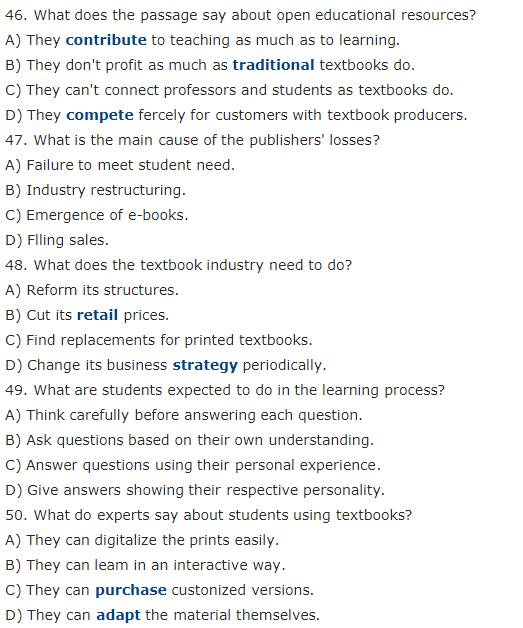
When we think of animals and plants, we have a pretty good way of dividing them into two distinct groups: one converts sunlight into energy and the other has to eat food to make its energy. Well, those dividing lines come crashing down with the discovery of a sea slug (海蛞蝓) that's truly half animal and half plant. It's pretty incredible how it has managed to hijack the genes of the algae (藻类) on which it feeds.
The slugs can manufacture chlorophyll, the green pigment (色素) in plants that captures energy from sunlight, and hold these genes within their body. The term kleptoplasty is used to describe the practice of using hijacked genes to create nutrients from sunlight. And so far, this green sea slug is the only known animal that can be truly considered solar-powered, although some animals do exhibit some plant-like behaviors. Many scientists have studied the green sea slugs to confirm that they are actually able to create energy from sunlight.
In fact, the slugs use the genetic material so well that they pass it on to their future generations. Their babies retain the ability to produce their own chlorophyll, though they can't generate energy from sunlight until they've eaten enough algae to steal the necessary genes, which they can't yet produce on their own.
"There's no way on earth that genes from an alga should work inside an animal cell," says Sidney Pierce from the University of South Florida. "And yet here, they do. They allow the animal to rely on sunshine for its nutrition. So if something happens to their food source, they have a way of not starving to death until they find more algae to eat."
The sea slugs are so good at gathering energy from the sun that they can live up to nine months without having to eat any food. They get all their nutritional needs met by the genes that they've hijacked from the algae.
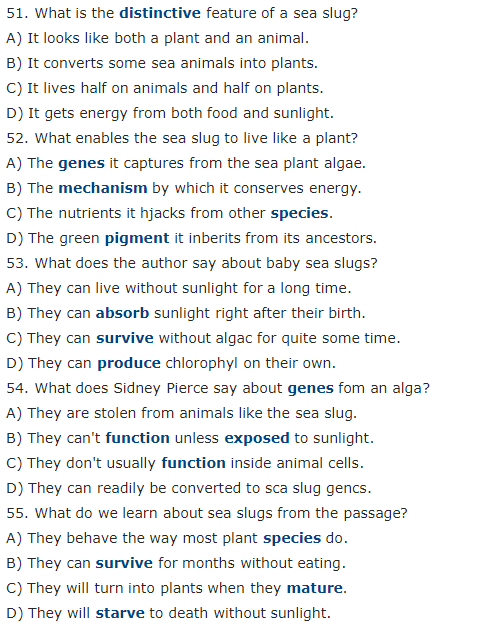
For this part, you are allowed 30 minutes to write a letter to a foreign friend who wants to teach English in China. Please recommend a city to him. You should write at least 120 words but no more than 180 words.
A) We've always been a hands-on, do it-yourself kind of nation. Ben Franklin, one of America's founding fathers, didn't just invent the lightning rod. His creations include glasses, innovative stoves and more.
B) Franklin, who was largely self-taught, may have been a genius, but he wasn't really an exception when it comes to American making and creativity.
C) The personal computing revolution and philosophy of disruptive innovation of Silicon Valley grew, in part, out of the creations of the Homebrew Computer Club, which was founded in a garage in Menlo Park, California, in the mid-1970s. Members-including guys named Jobs and Wozniak-started making and inventing things they couldn't buy.
D) So it's no surprise that the Maker Movement today is thriving in communities and some schools across America. Making is available to ordinary people who aren't tied to big companies, big defense labs or research universities. The maker philosophy echoes old ideas advocated by John Dewey, Montessori, and even ancient Greek philosophers, as we pointed out recently.
E) These maker spaces are often outside of classrooms, and are serving an important educational function. The Maker Movement is rediscovering learning by doing, which is Dewey's phrase from 100 years ago. We are rediscovering Dewey and Montessori and a lot of the practices that they pioneered that have been forgotten or at least put aside. A maker space is a place which can be in a school, but it doesn't look like a classroom. It can be in a library. It can be out in the community. It has tools and materials. It's a place where you get to make things based on your interest and on what you, re learning to do.
F) Ideas about learning by doing have struggled to become mainstream educationally, despite being old concepts from Dewey and Montessori, Plato and Aristotle, and in the American context, Ralph Emerson, on the value of experience and self-reliance. It's not necessarily an efficient way to learn. We learn, in a sense, by trial and error. Learning from experience is something that takes time and patience. It's very individualized. If your goal is to have standardized approaches to learning, where everybody learns the same thing at the same time in the same way, then learning by doing doesn't really fit that mold anymore. It's not the world of textbooks. It's not the world of testing.
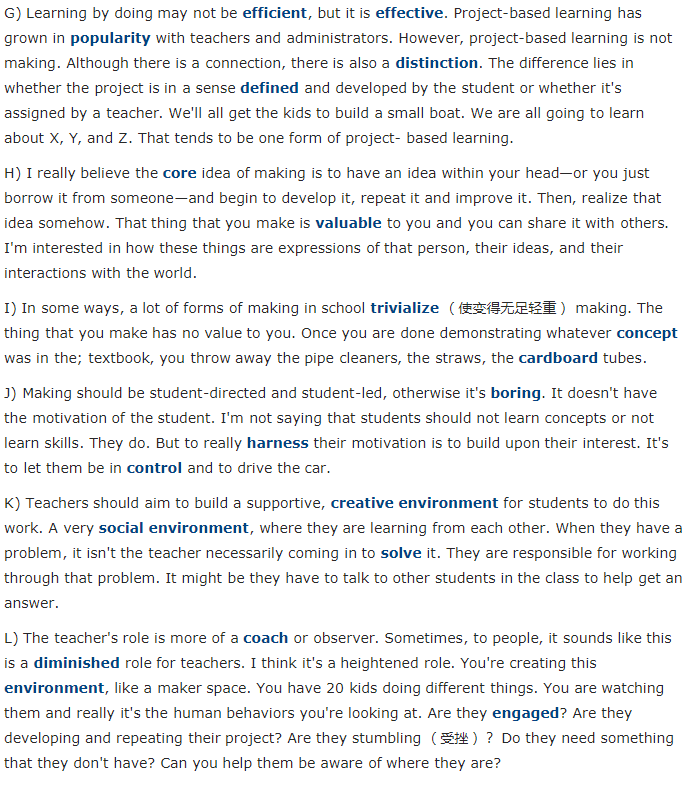
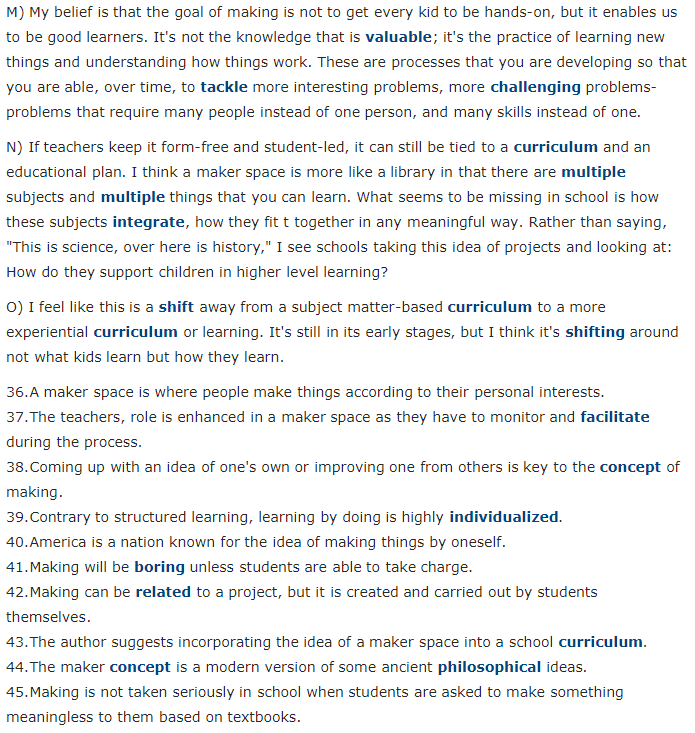
Professor Ashok Goel of Georgia Tech developed an artificially intelligent teaching assistant to help handle the enormous number of student questions in the online class, Knowledge-Based Artificial Intelligence. This online course is a core requirement of Georgia Tech's online Master of Science in Computer Science program. Professor Goel already had eight teaching assistants, but that wasn't enough to deal with the overwhelming number of daily questions from students.
Many students drop out of online courses because of the lack of teaching support. When students feel isolated or confused and reach out with questions that go unanswered, their motivation to continue begins to fade. Professor Goel decided to do something to remedy this situation and his solution was to create a virtual assistant named Jill Watson, which is based on the IBM Watson platform.
Goel and his team developed several versions of Jill Watson before releasing her to the online forums. At first, the virtual assistant wasn't too great. But Goel and his team sourced the online discussion forum to find all the 40,000 questions that had ever been asked since the class was launched. Then they began to feed Jill with the questions and answers. After some adjustments and sufficient time, Jill was able to answer the students' questions correctly 97% of the time. The virtual assistant became so advanced and realistic that the students didn't know she was a computer. The students, who were studying artificial intelligence, were interacting with the virtual assistant and couldn't tell it apart from a real human being. Goel didn't inform them about Jill's true identity until April 26. The students were actually very positive about the experience.
The goal of Professor Goel's virtual assistant next year is to take over answering 40% of all the questions posed by students on the online forum. The name Jill Watson will, of course, change to something else next semester. Professor Goel has a much rosier outlook on the future of artificial intelligence than, say, Elon Musk, Stephen Hawking, Bill Gates or Steve Wozniak.
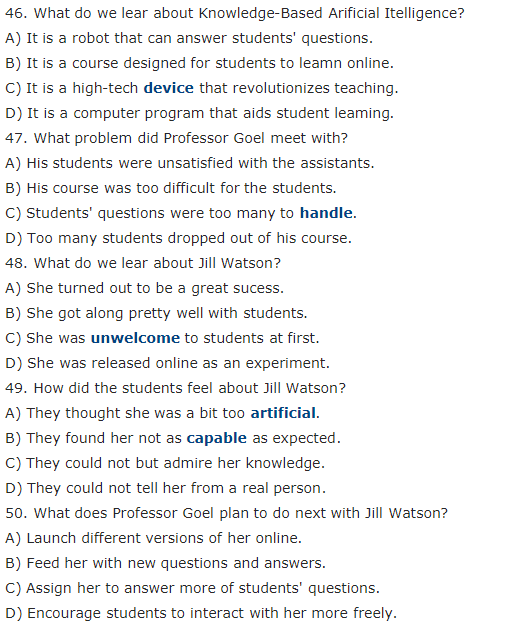
Thinking small, being engaging, and having a sense of humor don't hurt. Those are a few of the traits of successful science crowdfunding efforts that emerge from a recent study that examined nearly 400 campaigns. But having a large network and some promotional skills may be more crucial.
Crowdfunding, raising money for a project through online appeals, has taken off in recent years for everything from making movies to producing water-saving gadgets. Scientists have tried to tap Internet donors, too, with mixed success. Some raised more than twice their goals, but others have fallen short of reaching even modest targets.
To determine what separates science crowdfunding triumphs from failures, a team led by science communications scholar Mike Sch?fer of the University of Zurich examined the content of the webpages for 371 recent campaigns.
Four traits stood out for those that achieved their goals, the researchers report in Public Understanding of Science. For one, they use a crowdfunding platform that specializes in raising money for science, and not just any kind of project. Although sites like Kickstarter take all comers, platforms such as Experiment.com and Petridish.org only present scientific projects. For another, they present the project with a funny video because good visuals and a sense of humor improved success. Most of them engage with potential donors, since projects that answered questions from interested donors fared better. And they target a small amount of money. The projects included in the study raised $4,000 on average, with 30% receiving less than $1,000. The more money a project sought, the lower the chance it reached its goal, the researchers found.
Other factors may also significantly influence a project's success, most notably, the size of a scientist's personal and professional networks, and how much a researcher promotes a project on their own. Those two factors are by far more critical than the content on the page. Crowdfunding can be part of researchers' efforts to reach the public, and people give because "they feel a connection to the person" who is doing the fundraising—not necessarily to the science.
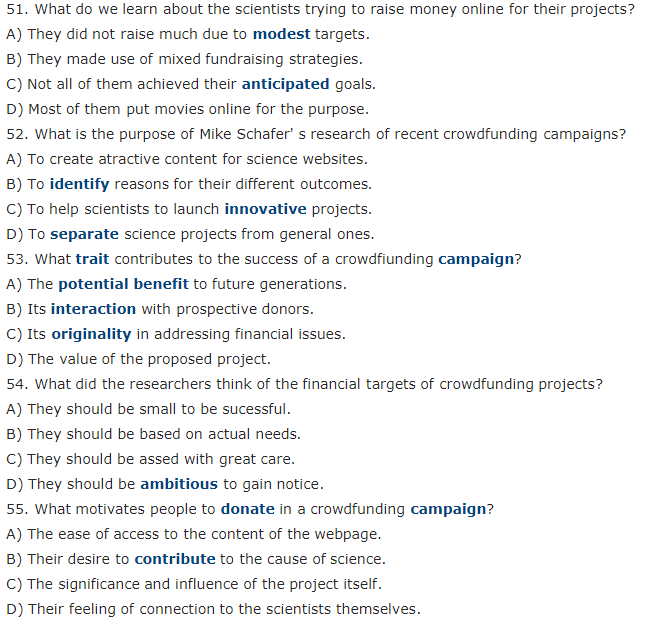
Directions: For this part, you are allowed 30 minutes to write a letter to a foreign friend who wants to study in China. Please recommend a university to him. You should write at least 120 words but no more than 180 words.
Directions: For this part, you are allowed 30 minutes to write a letter to a foreign friend who wants to teach English. Please recommend a city to him. You should write at least 120 words but no more than 180 words.
中国,地球上最吸引人的国家之一,有5000多年的历史,是目前全球第二大经济体(the second largest economy)。随着广泛的经济改革,中国正经历着显著、快速的变化。1949年以前的中国极端贫困、收入不平衡(incomeinequalities)、国家不安全。由于经济改革,从1980年开始,人民的生活水平开始提升至基本水平之上。全国人口有了足够的食物、衣服和住房,普通家庭可以吃得起各种各样的食物,穿得上时尚的衣服。
The fifth largest city in US passed a significant soda tax proposal that will levy (征税)1.5 cents per liquid ounce on distributors.
Philadelphil's new measure was approved by a 13 to 4 city council vote. It sets a new bar for similar initiatives across the country. It is proof that taxes on sugary drinks can win substantial support outside super-liberal areas. Until now, the only city to successfully pass and implement a soda tax was Berkeley, California, in 2014.
The tax will apply to regular and diet sodas, as well as other drinks with adder sugar, such as Gatorade and iced teas. It's expected to raise $410 million over the next five years, most of which will go toward funding a universal pre-kindergarten program for the city.
While the city council vote was met with applause inside the council room, opponents to the measure, including soda lobbyists, made sharp criticisms and a promise to challenge the tax in court.
"The tax passed today unfairly singles out beverages — including low —and no-calorie choices," said Lauren Kane, spokeswoman for the American Beverage Association. "But most importantly, it is against the law. So we will side with the majority of the people of Philadelphia who oppose this tax and take legal action to stop it."
An industry-backed anti-tax campaign has spent at least $4 million on advertisements. The ads criticized the measure, characterizing it as a "grocery tax".
Public health groups applauded the approved tax as step toward fixing certain lasting health issues that plague Americans. "The move to recapture a small part of the profits from an industry that pushed a product that contributes to diabetes, obesity and heart disease in poorer communities in order to reinvest in those communities will sure be inspirational to many other places," said Jim Krieger, executive director of Healthy Food America. "indeed, we are already hearing from some of them. It's not 'just Berkeley' anymore."
Similar measures in California's Albany, Oakland, San Francisco and Colorado's Boulder are becoming hot-button issues. Health advocacy groups have hinted that even more might be coming.
46. What does the passage say about the newly-approved soda tax in Philadelphia?
A) It will change the lifestyle of many consumers.
B) It may encourage other US cities to fllow suit.
C) It will cut soda consumption among low-income communities.
D) It may influence the marketing strategies of the soda business.
47. What will the opponents probably do to respond to the soda tax proposal?
A) Bargain with the city council.
B) Refuse to pay additional tax.
C) Take legal action against it.
D) Try to win public support.
48. What did the industry-backed anti-tax campaign do about the soda tax proposal?
A) It tried to arouse hostile felings among consumers.
B) It tried to win grocers' support against the measure.
C) It kept sending ltters of protest to the media.
D) It criticized the measure through advertising.
49. What did public health groups think the soda tax would do?
A) Alert people to the risk of sugar-induced diseases.
B) Help people to fix certain long-time health issues.
C) Add to the fund for their rescarch on discases.
D) Benefit low-income people across the country.
50. What do we lear about similar measures concening the soda tax in some other citics?
A) They are becoming rather sensitive issues.
B) They are spreading panic in the soda industry.
C) They are reducing the incidence of sugar-induced diseases.
D) They are taking away a lot of proft from the soda industry.